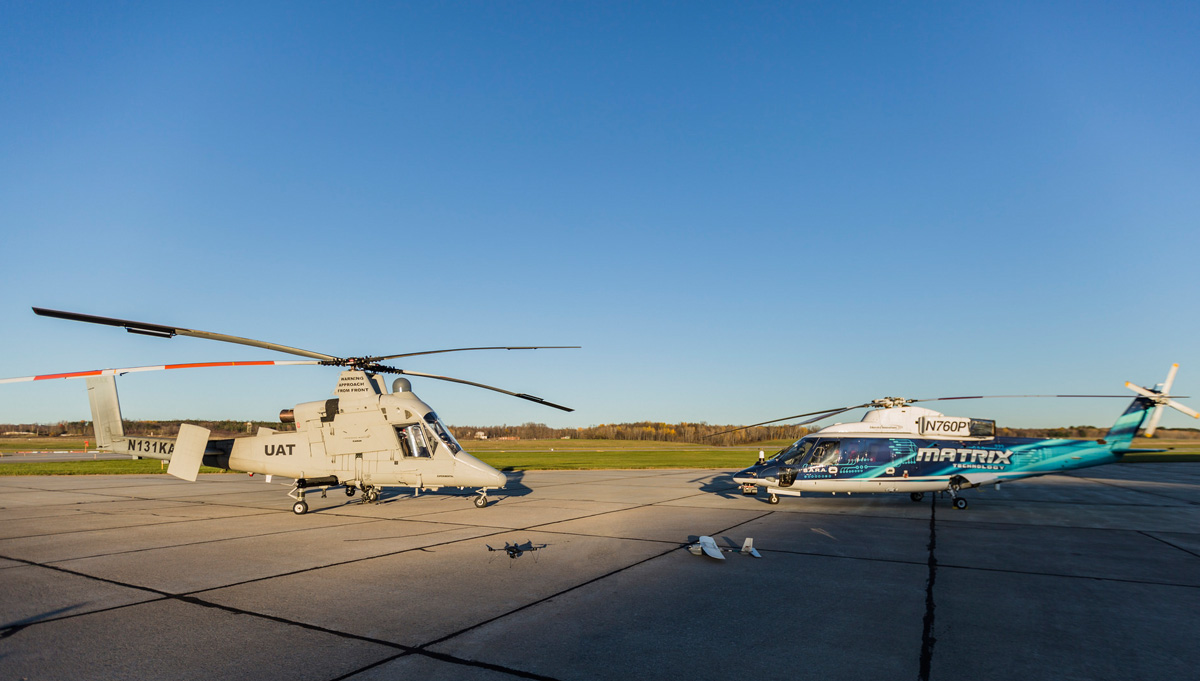Four autonomous vehicles collaborated for a joint operation organized by Lockheed Martin. For the first time its suite of optionally-piloted helicopters and small unmanned aerial systems worked together for a firefighting and lifesaving demonstration.
On Nov. 8, four autonomous vehicles collaborated in a very special mission of their potential: the K-MAX helicopter, the Sikorsky Autonomy Research Aircraft (SARA), the Desert Hawk 3.1 fixed wing unmanned aircraft, and the Indago quadrotor worked together to successfully locate and extinguish fires, pinpoint the location of a missing person, and bring that person to safety.First, Indago located hot spots and directed the K-MAX to drop water on the fire. Then, the Desert Hawk 3.1 surveyed the site and worked with K-MAX and SARA to complete a search and rescue mission."When lives are at risk, advanced human-machine teams can complete dangerous missions without putting others in harm's way," said Dan Spoor, vice president, unmanned systems. "The advances that Lockheed Martin is pioneering in autonomous and unmanned technologies will lead to improved safety and efficiency for humanitarian aid, first response and other civil, commercial and military operations in the air, on land and undersea."During this demonstration, the optionally piloted Kaman K-MAX and the Sikorsky Autonomy Research Aircraft (SARA) engaged in collaborative firefighting and search-and-rescue with the Indago quadrotor and Desert Hawk 3.1 fixed wing unmanned aircraft system (UAS) providing information, surveillance and reconnaissance.Also during the demonstration, the Indago identified hot spots and relayed that information to an operator who directed the K-MAX to autonomously retrieve water from a nearby pond and drop it onto the fire, thus extinguishing the flames.The Desert Hawk identified the location of a missing person and SARA, a modified S-76® commercial helicopter, conducted the search and directed the rescue. The Sikorsky MATRIX™ technology on SARA gives operators the confidence to fly large rotorcraft safely, reliably and affordably as autonomous or optionally piloted aircraft.Lockheed Martin integrated the MATRIX technology with K-MAX so that SARA and K-MAX could communicate with each other during the demonstration. Using information provided by K-MAX, SARA autonomously scanned the area and found a safe place to land."Our goal is to support the integration of autonomy into aviation to improve the safety and capabilities for military and commercial missions. Utilizing MATRIX to support the mission in this demonstration highlights an example of the ability to reduce pilot workload and augment mission performance," said Mark Miller, vice president, engineering and technology, Sikorsky, a Lockheed Martin Company.The New York UAS Test Site Operations Center at Griffiss International Airport also demonstrated progress toward UAS Traffic Management (UTM). The center uses radars and sensors to enable the tracking of manned, unmanned and optionally-piloted aircraft systems."UAS traffic management must keep pace with the technology innovations that are bringing helicopters to the sky with a laptop or tablet," said Lawrence Brinker, executive director & general counsel of the NUAIR Alliance. "The progress that has been made through the collaboration of federal agencies and companies like Lockheed Martin, will pave the way to help the Federal Aviation Administration safely manage air traffic without on-board pilots." As Lockheed states in their website, “the best person for the job isn’t always one”. Unmanned systems are changing the way militaries operate and protect forces, the way first responders fight fires and how researchers explore the ocean terrains. The success of an unmanned system in any domain is best demonstrated by the way it integrates with manned activity and serves as a capability multiplier, rather than a one-for-one swap. Lockheed Martin’s portfolio emphasizes the human-machine team to expand capabilities, whether conducting tactical surveillance in a war zone, dousing forest fires, moving supplies in a convoy or inspecting underwater pipelines.In that sense, the Indago quadrotor is a revelation. The collapsible Indago quadrotor UAS weighs less than 5 lbs. and folds into a man-packable unit that requires no tools for assembly. Indago can be unfolded in 60 seconds, and airborne in just 2.5 minutes. When airborne, the Indago can operate through wind, smoke, dust and flames to help firefighters identify the intensity and location of hot spots, as well as provide information on areas where people and property are at risk. The quadrotor as been used extensively in different areas from precision agriculture to inspection or disaster reflief. Its new role as firefighter opens new horizons for the use of drones when there is an urgent need to have an eye-in-the-sky in just minutes.
As Lockheed states in their website, “the best person for the job isn’t always one”. Unmanned systems are changing the way militaries operate and protect forces, the way first responders fight fires and how researchers explore the ocean terrains. The success of an unmanned system in any domain is best demonstrated by the way it integrates with manned activity and serves as a capability multiplier, rather than a one-for-one swap. Lockheed Martin’s portfolio emphasizes the human-machine team to expand capabilities, whether conducting tactical surveillance in a war zone, dousing forest fires, moving supplies in a convoy or inspecting underwater pipelines.In that sense, the Indago quadrotor is a revelation. The collapsible Indago quadrotor UAS weighs less than 5 lbs. and folds into a man-packable unit that requires no tools for assembly. Indago can be unfolded in 60 seconds, and airborne in just 2.5 minutes. When airborne, the Indago can operate through wind, smoke, dust and flames to help firefighters identify the intensity and location of hot spots, as well as provide information on areas where people and property are at risk. The quadrotor as been used extensively in different areas from precision agriculture to inspection or disaster reflief. Its new role as firefighter opens new horizons for the use of drones when there is an urgent need to have an eye-in-the-sky in just minutes.















Comments